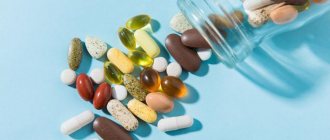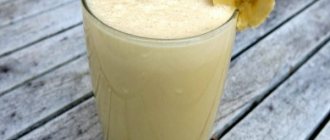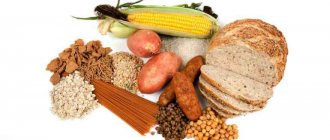Vitamin interactions
To support vitality and prevent a number of diseases, many people prefer to use multivitamin pharmaceuticals. When choosing such drugs, it is important to take into account the compatibility of the vitamins that are present in a particular drug. We can speak of a correct combination if 2 or more components interact with each other, and they enhance each other’s effect and have a positive effect.
With a deficiency of one or more nutrients, as well as with their excess, a person develops serious health problems.
To exclude such conditions, the combination of vitamins must be correct and balanced.
- A and E interact well with each other, but there should be less of the latter, otherwise the absorption of the former is impaired;
- B2 (riboflavin) and B6 (pyridoxine) are ideal with K;
- B12 can be combined with B5;
- P enhances the properties of vitamin C, E, B9 (folic acid);
- F enhances the properties of A, D, E, as well as group B;
- B6 (pyridoxine) and B2;
- B12 (cyanocobalamin) is recommended to be used in combination with B5, B9;
- Vitamin C increases the activity of vitamin E.
With the right combination, there will be a certain result, which will be different from if each component is taken separately.
What vitamins cannot be combined
Good compatibility of vitamins can provide the body’s daily needs. If you take substances that interact poorly with each other, at best there will be no effect from such treatment, and at worst, the risk of developing side effects will increase.
Before you start taking vitamins, you should familiarize yourself with their compatibility with each other.
Poor compatibility can disrupt the absorption of one or more components.
- Vitamin D cannot be combined with A, since they neutralize each other’s effects;
- Vitamin B2 leads to the oxidation of B1;
- Vitamin B1, if combined with B12, can cause an allergic reaction;
- Vitamin D is not absorbed if taken with vitamin E;
- Vitamin B12 eliminates the properties of C and PP;
- Vitamins A and D neutralize each other;
- Vitamins E and D must be taken separately, since the first component is poorly absorbed under the influence of another substance;
- Oxidation of vitamin B1 occurs under the influence of vitamin B2.
Many multivitamins contain substances that interact poorly with each other, but their composition is selected in such a way that it does not have a negative effect on the human body.
Foods that contain vitamin B1 - thiamine
When thiamine enters the body, it accumulates in the muscle tissue of the skeleton, brain, heart, and gastrointestinal tract.
Vitamin deficiency develops with a poor diet, alcohol or nicotine abuse, and is often accompanied by neurological disorders. The daily requirement for the substance is 1-1.2 mg.
It is found in large quantities in foods of plant origin and certain meat products.
Main food sources of thiamine (in mg per 100 g of product):
Foods high in vitamin B1.
- bread made from wheat flour - 0.18-0.23 mg;
- soybean - 0.3-0.7 mg;
- legumes (chickpeas, peas, lentils, beans) - 0.5 mg;
- sunflower seeds - 1.8 mg;
- greens (sorrel, spinach, asparagus, parsley) - 0.1-0.2 mg;
- vegetables (carrots, celery, beets, potatoes, cabbage) - 0.08-0.15 mg;
- fruits (pineapple, durian, tangerine, plum) - 0.08-0.3 mg;
- dried fruits (dried apricots, raisins) - 0.1-0.15 mg;
- offal (beef or pork liver, brain, heart) - 0.08-0.12 mg;
- nuts (hazelnuts, pistachios, cashews, peanuts) - 0.4-0.8 mg;
- yeast - 0.4 mg;
- flour (rye, wheat, buckwheat) - 0.4-0.5 mg.
Which microelements can and cannot be combined
Microelements are building materials for many biological processes. Their compatibility has been well studied, which allows many pharmaceutical companies to produce various multivitamin medications that contain 2 or more active ingredients.
- Iron and copper interact with vitamin A and B2;
- Vitamin B2 increases the healing properties of zinc, which improves the absorption of A;
- Magnesium interacts with B vitamins, with the exception of vitamin B1;
- Bromine increases the absorption of phosphorus, calcium and magnesium;
- A good combination is zinc and selenium in combination with A and E, Omega-3.
Not all minerals interact well with vitamins. Some of them interfere with the absorption of beneficial components, while others reduce their effectiveness.
There are many examples of bad combinations of organic compounds:
- Vitamin B1 is poorly compatible with magnesium and calcium;
- Iron and copper interfere with the absorption of vitamin B2;
- Vitamin B9, together with zinc, promotes the formation of insoluble compounds, which impairs their absorption;
- Iron, copper and manganese make vitamin B12 inactive;
- Vitamin C enhances the removal of copper from the body.
In the process of producing multivitamins, the manufacturer always takes into account the permissible doses of one or another component of the medicine.
Vitamin compatibility chart
The table will help you become more familiar with the possible combination of useful components.
- “+” - good;
- “-” - bad;
- “#” is neutral.
| A | IN 1 | AT 2 | AT 5 | AT 6 | AT 9 | AT 12 | WITH | E | D | |
| A | A | # | # | # | # | # | — | # | + | # |
| IN 1 | # | IN 1 | # | # | # | # | # | # | # | # |
| AT 2 | # | # | AT 2 | # | + | + | — | # | # | # |
| AT 5 | # | # | # | AT 5 | # | # | + | # | # | # |
| AT 6 | # | # | + | # | AT 6 | # | # | # | # | |
| AT 9 | # | # | + | # | # | AT 9 | + | # | # | # |
| AT 12 | — | # | — | + | # | + | AT 12 | — | — | # |
| WITH | # | # | # | # | # | # | — | WITH | + | # |
| E | + | # | # | # | # | # | — | + | E | # |
| D | # | # | # | # | # | # | # | # | # | D |
Multivitamin Review
Domestic and foreign companies are making a lot of efforts to combine several compounds in one drug. They use a special controlled release technology, which allows them to combine incompatible components with different absorption intervals in one tablet. Thanks to such developments, there are quite a lot of multivitamin complexes on the market, the main purpose of which is to provide a person with the daily requirement of all nutritional components.
Multivitamins contain at once all the vitamins that are combined with each other, which are necessary for normal life.
Multivitamin preparations that contain a large number of organic compounds necessary for the full functioning of the human body are popular.
Most multivitamins have the same composition, which contains the most popular compounds:
- Vitamin A – improves vision, condition of skin, hair, improves the rheological properties of blood;
- B vitamins – participate in metabolic processes, improve the functioning of the central nervous system;
- Vitamin C – improves immunity;
- Vitamin D – promotes healthy growth, strengthens the skeletal system;
- Vitamin E – supports normal functioning of the immune and nervous systems;
- Vitamin F and Omega-3 fatty acids are components for the full functioning of brain structures and myocardium.
All these organic compounds are present in any multivitamin medicine, but they are usually supplemented with microelements. The amount of each component depends on the purpose of the medicine itself: for children, adults or pregnant women. Sometimes such drugs have a medical purpose, that is, they are intended as an auxiliary therapy for a specific disease.
Nutritional supplements containing a number of useful components do not contain chemical components. Rich in fat-soluble and water-soluble vitamins, macro- and microelements for the normal functioning of all organs and systems.
Complivit
Complivit contains group B compounds and ascorbic acid. It has a positive effect on the functionality of the body, regulates energy and metabolic processes, accelerates the regeneration of damaged tissues, and increases the body’s resistance to various viral and bacterial infections.
As a preventive measure, Complivit is prescribed 1 tablet per day. In case of vitamin deficiency, the dose can be increased to 2 times a day. The duration of treatment is 30 days.
Supradin
Supradin is one of the three best vitamin and mineral pharmaceutical preparations. Contains 8 vitamins and 12 microelements. It is recommended to use Supradin for the treatment and prevention of vitamin deficiency, unbalanced nutrition, reduced immunity, increased physical and mental stress during the period of active growth of adolescents.
According to many doctors, Supradin is especially effective in the spring, when nutrient reserves are depleted. Like any other pharmaceutical drug, Supradin has some contraindications that you need to familiarize yourself with before taking it.
Vitrum
Its rich composition allows it to be used as a therapeutic or prophylactic agent for a number of diseases. Vitrum not only stimulates the body's protective properties, but also improves the functioning of internal organs and systems.
Regular use of Vitrum completely provides a person with the necessary nutrients, improves the condition of hair, nails and skin, and increases the body's resistance to a large number of diseases. Tablets are taken once a day for 1 month.
The instructions contain a number of contraindications and side effects that you should read before use.
Multitabs
Multitabs is a popular line of multivitamins for adults and children. Recommended as a preventive or therapeutic agent in the fight against various diseases and conditions. Multitabs “classic” contains 10 vitamins and 7 macro- and microelements. A distinctive feature is the presence of iodine, which is absent in other similar medicines.
Multitabs improves the functioning of the cardiovascular and nervous systems, neutralizes free radicals, cleanses the body of toxins, and stimulates the immune system.
The daily dose is 1 tablet, washed down with a small amount of water. Take 1 hour before meals. Contraindications include hypersensitivity to the composition. When taken correctly, side effects are very rare.
Alphabet
The alphabet is designed in different variations for adults and children. The uniqueness lies in the fact that the package contains tablets of 3 different colors. Each tablet contains specific vitamins and minerals and is taken at the prescribed time. Thanks to this combination of nutrients, the risk of developing an allergic reaction or side effects due to incompatibility of the components is significantly reduced. Allows you to provide an antioxidant effect, improve the rheological composition of the blood, and protect against various diseases.
Pikovit
On the pharmacological market, Pikovit is available in 2 forms - tablets and syrup for children. It has a balanced composition, which contains a number of organic compounds. Designed to suit all needs. In addition to the main substances, it contains calcium and phosphorus, vit. D for active and healthy growth, as well as the prevention of rickets.
Taking Pikovit increases learning abilities and supports the functioning of all functions. This multivitamin is most often used in pediatrics. Tablets are recommended for children from 4 years of age, and syrup from 1 year. A small list of contraindications and good tolerability make Pikovit one of the safe and effective multivitamins.
Not all vitamins and minerals are compatible with each other
Vitamin K content in foods
Table of percentage of vitamin K in foods. The chart shows the percentage of vitamin K required per day based on a 100g serving.
| № | Quantity | Share of daily value per 100 g | |
| 1 | Dry basil | 1,714.5 mcg | 1 428,8% |
| 2 | Ground sage | 1,714.5 mcg | 1 428,8% |
| 3 | Dried thyme | 1,714.5 mcg | 1 428,8% |
| 4 | Fresh parsley | 1,640.0 mcg | 1 366,7% |
| 5 | Dried parsley | 1,359.5 mcg | 1 132,9% |
| 6 | Dried coriander (cilantro) leaf | 1,359.5 mcg | 1 132,9% |
| 7 | Fresh amaranth leaves | 1,140.0 mcg | 950,0% |
| 8 | Fresh chard | 830.0 mcg | 691,7% |
| 9 | Fresh dandelion leaves | 778.4 mcg | 648,7% |
| 10 | Raw curly cabbage | 704.8 mcg | 587,3% |
| 11 | Oregano oregano, dried | 621.7 mcg | 518,1% |
| 12 | Marjoram spice powder | 621.7 mcg | 518,1% |
| 13 | Fresh watercress | 541.9 mcg | 451,6% |
| 14 | Boiled white mari | 494.2 mcg | 411,8% |
| 15 | Boiled spinach | 493.6 mcg | 411,3% |
| 16 | Fresh spinach | 482.9 mcg | 402,4% |
| 17 | Canned spinach | 461.6 mcg | 384,7% |
| 18 | Fresh kale | 437.1 mcg | 364,3% |
| 19 | Fresh basil | 414.8 mcg | 345,7% |
| 20 | Cooked cabbage (boiled) | 406.6 mcg | 338,8% |
| 21 | Fresh beet tops | 400.0 mcg | 333,3% |
| 22 | Frozen spinach | 372.0 mcg | 310,0% |
| 23 | New Zealand fresh spinach | 337.0 mcg | 280,8% |
| 24 | Cilantro (coriander leaves) fresh | 310.0 mcg | 258,3% |
| 25 | Fresh chicory leaves | 297.6 mcg | 248,0% |
| 26 | Fresh mustard greens | 257.5 mcg | 214,6% |
| 27 | Broccoli raab cooked | 256.0 mcg | 213,3% |
| 28 | Radicchio fresh | 255.2 mcg | 212,7% |
| 29 | Fresh turnip tops | 251.0 mcg | 209,2% |
| 30 | Raw beetroot | 250.0 mcg | 208,3% |
| 31 | Fresh endive | 231.0 mcg | 192,5% |
| 32 | Fresh broccoli raab | 224.0 mcg | 186,7% |
| 33 | Fresh chives | 212.7 mcg | 177,3% |
| 34 | Escarole cooked | 211.9 mcg | 176,6% |
| 35 | Fresh onion | 193.4 mcg | 161,2% |
| 36 | Soybean oil | 183.9 mcg | 153,3% |
| 37 | Fresh Brussels sprouts | 177.0 mcg | 147,5% |
| 38 | Ground black pepper | 163.7 mcg | 136,4% |
| 39 | Mayonnaise | 163.0 mcg | 135,8% |
| 40 | Fresh green onion | 156.3 mcg | 130,3% |
| 41 | Cloves (spice) seasoning powder | 141.8 mcg | 118,2% |
| 42 | Boiled broccoli | 141.1 mcg | 117,6% |
| 43 | Boiled Brussels sprouts | 140.3 mcg | 116,9% |
| 44 | Fresh red lettuce | 140.3 mcg | 116,9% |
| 45 | Fresh lettuce | 126.3 mcg | 105,3% |
| 46 | Boiled cabbage (white cabbage) | 108.7 mcg | 90,6% |
| 47 | Fresh arugula | 108.6 mcg | 90,5% |
| 48 | Fresh grape leaves | 108.6 mcg | 90,5% |
| 49 | Hot chili peppers dried in the sun | 108.2 mcg | 90,2% |
| 50 | Dried carrots | 108.0 mcg | 90,0% |
| 51 | Ground dry chili pepper | 105.7 mcg | 88,1% |
| 52 | Fresh Roman salad | 102.5 mcg | 85,4% |
| 53 | Fresh head lettuce | 102.3 mcg | 85,3% |
| 54 | Fresh broccoli | 101.6 mcg | 84,7% |
| 55 | Broccoli frozen | 101.4 mcg | 84,5% |
| 56 | Margarine | 91.7 mcg | 76,4% |
| 57 | Chinese fresh broccoli | 89.1 mcg | 74,3% |
| 58 | Chinese cooked broccoli | 84.8 mcg | 70,7% |
| 59 | Paprika spice, powder form | 80.3 mcg | 66,9% |
| 60 | Fresh cabbage, white cabbage | 76.0 mcg | 63,3% |
| 61 | Canola oil | 71.3 mcg | 59,4% |
| 62 | Soy flour | 70.0 mcg | 58,3% |
| 63 | Fresh savoy cabbage | 68.8 mcg | 57,3% |
| 64 | Raw seaweed | 66.0 mcg | 55,0% |
| 65 | Fennel, raw (fruit or root) | 62.8 mcg | 52,3% |
| 66 | Olive oil | 60.2 mcg | 50,2% |
| 67 | Onion rings | 55.8 mcg | 46,5% |
| 68 | Pine nut without shell | 53.9 mcg | 44,9% |
| 69 | Boiled asparagus | 50.6 mcg | 42,2% |
| 70 | Boiled green beans (asparagus) | 47.9 mcg | 39,9% |
| 71 | Pickled cucumbers (pickled) | 47.0 mcg | 39,2% |
| 72 | Soybeans, mature, dry | 47.0 mcg | 39,2% |
| 73 | Fresh leek | 47.0 mcg | 39,2% |
| 74 | Fresh Chinese cabbage | 45.5 mcg | 37,9% |
| 75 | Frozen green beans (asparagus) | 44.8 mcg | 37,3% |
| 76 | Sauerkraut (kimchi) | 43.6 mcg | 36,3% |
| 77 | Raw green beans, asparagus | 43.0 mcg | 35,8% |
| 78 | Raw asparagus | 41.6 mcg | 34,7% |
| 79 | Canned asparagus | 41.3 mcg | 34,4% |
| 80 | Celery root, raw | 41.0 mcg | 34,2% |
| 81 | Fresh kiwi | 40.3 mcg | 33,6% |
| 82 | Fresh red cabbage | 38.2 mcg | 31,8% |
| 83 | Roasted cashews | 34.7 mcg | 28,9% |
| 84 | Cashew raw | 34.1 mcg | 28,4% |
| 85 | Corn chips (nachos) without salt | 33.6 mcg | 28,0% |
| 86 | Fresh sprouted mung bean | 33.0 mcg | 27,5% |
| 87 | Frozen edamame | 31.4 mcg | 26,2% |
| 88 | Raw okra | 31.3 mcg | 26,1% |
| 89 | Cinnamon powder | 31.2 mcg | 26,0% |
| 90 | Fresh sprouted alfalfa seeds | 30.5 mcg | 25,4% |
| 91 | Rhubarb stem raw | 29.3 mcg | 24,4% |
| 92 | Fresh celery | 29.3 mcg | 24,4% |
| 93 | Chocolate cupcake with chocolate icing | 28.9 mcg | 24,1% |
| 94 | Frozen green peas | 27.9 mcg | 23,3% |
| 95 | Edamame cooked | 26.7 mcg | 22,3% |
| 96 | Prunes | 26.1 mcg | 21,8% |
| 97 | Boiled green peas | 25.9 mcg | 21,6% |
| 98 | Dried spirulina (in powder form) | 25.5 mcg | 21,3% |
| 99 | Leeks cooked | 25.4 mcg | 21,2% |
| 100 | Fresh green peas | 24.8 mcg | 20,7% |
| 101 | Oat oil | 24.7 mcg | 20,6% |
| 102 | Cottonseed oil | 24.7 mcg | 20,6% |
| 103 | Cacao butter | 24.7 mcg | 20,6% |
| 104 | Wheat germ oil | 24.7 mcg | 20,6% |
| 105 | Rice bran oil | 24.7 mcg | 20,6% |
| 106 | Pickled capers | 24.6 mcg | 20,5% |
| 107 | Fresh iceberg lettuce | 24.1 mcg | 20,1% |
| 108 | Abalone raw | 23.0 mcg | 19,2% |
| 109 | Parsnip root raw | 22.5 mcg | 18,8% |
| 110 | Agave syrup sugar substitute, sweetener | 22.5 mcg | 18,8% |
| 111 | Fried onions | 21.6 mcg | 18,0% |
| 112 | Canned green peas | 21.4 mcg | 17,8% |
| 113 | Avocado fresh | 21.0 mcg | 17,5% |
| 114 | Dried pear | 20.4 mcg | 17,0% |
| 115 | Fresh blackberries | 19.8 mcg | 16,5% |
| 116 | Frozen blackberries | 19.8 mcg | 16,5% |
| 117 | Fresh blueberries | 19.3 mcg | 16,1% |
| 118 | Boiled soybeans (ripe) | 19.2 mcg | 16,0% |
| 119 | Dry red beans (Kidney) | 19.0 mcg | 15,8% |
| 120 | Frozen carrots | 17.6 mcg | 14,7% |
| 121 | Fresh pomegranate | 16.4 mcg | 13,7% |
| 122 | Fresh cucumbers | 16.4 mcg | 13,7% |
| 123 | Frozen blueberries | 16.4 mcg | 13,7% |
| 124 | Dried peach | 15.7 mcg | 13,1% |
| 125 | Dried figs | 15.6 mcg | 13,0% |
| 126 | Canned carrot juice | 15.5 mcg | 12,9% |
| 127 | Fresh cauliflower | 15.5 mcg | 12,9% |
| 128 | Canned blackberry juice | 15.2 mcg | 12,7% |
| 129 | Walnut oil | 15.0 mcg | 12,5% |
| 130 | Fresh artichokes | 14.8 mcg | 12,3% |
| 131 | Boiled artichokes | 14.8 mcg | 12,3% |
| 132 | Frozen cauliflower | 14.8 mcg | 12,3% |
| 133 | Naranjilla frozen | 14.6 mcg | 12,2% |
| 134 | Grapes (red or green) fresh | 14.6 mcg | 12,2% |
| 135 | Dry, ripe peas | 14.5 mcg | 12,1% |
| 136 | Green hot chili pepper fresh | 14.3 mcg | 11,9% |
| 137 | Fresh hazelnuts | 14.2 mcg | 11,8% |
| 138 | Cracker | 14.2 mcg | 11,8% |
| 139 | Red hot fresh chili pepper | 14.0 mcg | 11,7% |
| 140 | Boiled cauliflower | 13.8 mcg | 11,5% |
| 141 | Boiled carrots | 13.7 mcg | 11,4% |
| 142 | Multigrain crispbread | 13.7 mcg | 11,4% |
| 143 | Sesame oil | 13.6 mcg | 11,3% |
| 144 | Turmeric spice powder | 13.4 mcg | 11,2% |
| 145 | Potato chips without salt | 13.3 mcg | 11,1% |
| 146 | Carrots raw (fresh) | 13.2 mcg | 11,0% |
| 147 | Roasted pistachios (no salt) | 13.2 mcg | 11,0% |
| 148 | Roasted salted pistachios | 13.2 mcg | 11,0% |
| 149 | Dried mango | 13.2 mcg | 11,0% |
| 150 | Sauerkraut | 13.0 mcg | 10,8% |
| 151 | Caramel popcorn | 12.5 mcg | 10,4% |
| 152 | Canned anchovies (in oil) | 12.1 mcg | 10,1% |
| 153 | Canned tomato paste | 11.4 mcg | 9,5% |
| 154 | Fresh red or white currants | 11.0 mcg | 9,2% |
| 155 | Mars chocolate bar (almond) | 10.9 mcg | 9,1% |
| 156 | Canned pomegranate juice | 10.4 mcg | 8,7% |
| 157 | Fresh vegetable physalis | 10.1 mcg | 8,4% |
| 158 | Green tomatoes, raw | 10.1 mcg | 8,4% |
| 159 | Canned carrots | 9.8 mcg | 8,2% |
| 160 | Donuts | 9.8 mcg | 8,2% |
| 161 | Canned beef stew | 9.6 mcg | 8,0% |
| 162 | Flaxseed oil | 9.3 mcg | 7,8% |
| 163 | Chickpea flour | 9.1 mcg | 7,6% |
| 164 | Chocolate white | 9.1 mcg | 7,6% |
| 165 | Dry chickpeas | 9.0 mcg | 7,5% |
| 166 | Beans, raw, mature | 9.0 mcg | 7,5% |
| 167 | Dry mung bean | 9.0 mcg | 7,5% |
| 168 | Dry potato flakes (instant puree) | 8.7 mcg | 7,3% |
| 169 | Butter | 8.6 mcg | 7,2% |
| 170 | Tortilla | 8.6 mcg | 7,2% |
| 171 | Boiled red beans (Kidney) | 8.4 mcg | 7,0% |
| 172 | Dark chocolate (45-59% cocoa) | 8.1 mcg | 6,8% |
| 173 | Oatmeal cookies | 8.0 mcg | 6,7% |
| 174 | Palm oil | 8.0 mcg | 6,7% |
| 175 | Fresh tomatoes | 7.9 mcg | 6,6% |
| 176 | Fresh mulberries | 7.8 mcg | 6,5% |
| 177 | Whole grain wheat bread | 7.8 mcg | 6,5% |
| 178 | Salted mackerel | 7.8 mcg | 6,5% |
| 179 | Frozen logan berry | 7.8 mcg | 6,5% |
| 180 | Fresh raspberries | 7.8 mcg | 6,5% |
| 181 | Dried cranberries | 7.6 mcg | 6,3% |
| 182 | Green bell pepper, fresh | 7.4 mcg | 6,2% |
| 183 | French fries | 7.4 mcg | 6,2% |
| 184 | Dark chocolate (70-85% cocoa) | 7.3 mcg | 6,1% |
| 185 | Peeled pumpkin seeds | 7.3 mcg | 6,1% |
| 186 | Dark chocolate (60-69% cocoa) | 7.2 mcg | 6,0% |
| 187 | Safflower oil | 7.1 mcg | 5,9% |
| 188 | Almond oil | 7.0 mcg | 5,8% |
| 189 | Buckwheat flour | 7.0 mcg | 5,8% |
| 190 | Marshmallows in chocolate | 7.0 mcg | 5,8% |
| 191 | Veal cooked | 6.6 mcg | 5,5% |
| 192 | Breadcrumbs | 6.6 mcg | 5,5% |
| 193 | Fresh plum | 6.4 mcg | 5,3% |
| 194 | Whole grain sorghum flour | 6.4 mcg | 5,3% |
| 195 | Rye bread | 6.0 mcg | 5,0% |
| 196 | Dry Lima beans | 6.0 mcg | 5,0% |
| 197 | Rye grain (rye) in dry form | 5.9 mcg | 4,9% |
| 198 | Rye flour | 5.9 mcg | 4,9% |
| 199 | Pepperoni sausage | 5.8 mcg | 4,8% |
| 200 | Milk chocolate | 5.7 mcg | 4,8% |
| 201 | Dry pink beans | 5.7 mcg | 4,8% |
| 202 | Focaccia | 5.7 mcg | 4,8% |
| 203 | Twix chocolate bar | 5.6 mcg | 4,7% |
| 204 | Dry variegated beans (Pinto) | 5.6 mcg | 4,7% |
| 205 | Dry black beans | 5.6 mcg | 4,7% |
| 206 | Fried chicken egg | 5.6 mcg | 4,7% |
| 207 | Mustard seeds ground mustard | 5.4 mcg | 4,5% |
| 208 | Jeera cumin seeds | 5.4 mcg | 4,5% |
| 209 | Sunflower oil | 5.4 mcg | 4,5% |
| 210 | Dry baked muesli (granola), crispy, with honey | 5.3 mcg | 4,4% |
| 211 | Prickly pear (leaves) raw | 5.3 mcg | 4,4% |
| 212 | Raw wakame seaweed | 5.3 mcg | 4,4% |
| 213 | KitKat chocolate bar | 5.2 mcg | 4,3% |
| 214 | Pear Conference fresh | 5.2 mcg | 4,3% |
| 215 | Bread crackers | 5.2 mcg | 4,3% |
| 216 | Baked goose | 5.1 mcg | 4,3% |
| 217 | Cranberry juice without sugar | 5.1 mcg | 4,3% |
| 218 | Peas boiled in water (ripe) | 5.0 mcg | 4,2% |
| 219 | Irish moss raw | 5.0 mcg | 4,2% |
| 220 | Fresh cranberries | 5.0 mcg | 4,2% |
| 221 | Raw mackerel | 5.0 mcg | 4,2% |
| 222 | Dry black-eyed beans | 5.0 mcg | 4,2% |
| 223 | Dry lentils | 5.0 mcg | 4,2% |
| 224 | Fresh red bell pepper | 4.9 mcg | 4,1% |
| 225 | White wheat bread | 4.9 mcg | 4,1% |
| 226 | Cooked pheasant | 4.9 mcg | 4,1% |
| 227 | Fresh figs | 4.7 mcg | 3,9% |
| 228 | Egg omelette | 4.5 mcg | 3,8% |
| 229 | Fresh pear | 4.4 mcg | 3,7% |
| 230 | Cheesecake | 4.4 mcg | 3,7% |
| 231 | Raw zucchini | 4.3 mcg | 3,6% |
| 232 | Chicken breast, boiled or stewed (without skin) | 4.3 mcg | 3,6% |
| 233 | Flaxseed | 4.3 mcg | 3,6% |
| 234 | Dried apples | 4.3 mcg | 3,6% |
| 235 | Fried or baked zucchini (without oil) | 4.2 mcg | 3,5% |
| 236 | Frozen zucchini | 4.2 mcg | 3,5% |
| 237 | Mango fresh | 4.2 mcg | 3,5% |
| 238 | Chayote raw | 4.1 mcg | 3,4% |
| 239 | Red beans (Kidney) canned | 4.1 mcg | 3,4% |
| 240 | Cooked chicken back (meat with skin) | 4.1 mcg | 3,4% |
| 241 | Onion powder | 4.1 mcg | 3,4% |
| 242 | Nori seaweed, raw | 4.0 mcg | 3,3% |
| 243 | Boiled chickpeas | 4.0 mcg | 3,3% |
| 244 | Chicken drumstick, stewed or boiled (meat with skin) | 4.0 mcg | 3,3% |
| 245 | Baked chicken legs (meat with skin) | 3.9 mcg | 3,3% |
| 246 | Chicken thighs, boiled or stewed (meat with skin) | 3.9 mcg | 3,3% |
| 247 | Frozen red bell pepper | 3.8 mcg | 3,2% |
| 248 | Duck (duck meat) baked (meat without skin) | 3.8 mcg | 3,2% |
| 249 | Boiled pink beans | 3.7 mcg | 3,1% |
| 250 | Fried potato | 3.7 mcg | 3,1% |
| 251 | Chocolate bar Milky Way | 3.6 mcg | 3,0% |
| 252 | Spelled cereal in dry form | 3.6 mcg | 3,0% |
| 253 | Skinless chicken thighs, boiled or stewed | 3.6 mcg | 3,0% |
| 254 | Boiled variegated beans (Pinto) | 3.5 mcg | 2,9% |
| 255 | Feijoa fresh | 3.5 mcg | 2,9% |
| 256 | Fresh eggplant | 3.5 mcg | 2,9% |
| 257 | Cooked squash | 3.5 mcg | 2,9% |
| 258 | Pecan | 3.5 mcg | 2,9% |
| 259 | Seedless raisins | 3.5 mcg | 2,9% |
| 260 | Boiled or stewed chicken legs (meat with skin) | 3.5 mcg | 2,9% |
| 261 | Chicken drumstick (without skin), stewed or boiled | 3.4 mcg | 2,8% |
| 262 | Paratha flatbread | 3.4 mcg | 2,8% |
| 263 | Beef liver, stewed or fried | 3.3 mcg | 2,8% |
| 264 | Boiled black beans | 3.3 mcg | 2,8% |
| 265 | Canned apricots | 3.3 mcg | 2,8% |
| 266 | Patisson raw | 3.3 mcg | 2,8% |
| 267 | Fresh apricot | 3.3 mcg | 2,8% |
| 268 | Baked chicken thighs (meat with skin) | 3.3 mcg | 2,8% |
| 269 | Oat flour | 3.2 mcg | 2,7% |
| 270 | Unheated oat bran | 3.2 mcg | 2,7% |
| 271 | Crookneck pumpkin, raw | 3.2 mcg | 2,7% |
| 272 | Baked chicken drumstick (meat with skin) | 3.2 mcg | 2,7% |
| 273 | Fresh green Granny Smith apples | 3.2 mcg | 2,7% |
| 274 | Beef liver raw | 3.1 mcg | 2,6% |
| 275 | Dried apricots | 3.1 mcg | 2,6% |
| 276 | Ketchup | 3.0 mcg | 2,5% |
| 277 | Dried apples | 3.0 mcg | 2,5% |
| 278 | Fresh melon | 2.9 mcg | 2,4% |
| 279 | Raw red potatoes | 2.9 mcg | 2,4% |
| 280 | Canned white beans | 2.9 mcg | 2,4% |
| 281 | Cooked eggplant | 2.9 mcg | 2,4% |
| 282 | Raw chicken skin | 2.9 mcg | 2,4% |
| 283 | Boiled beans (ripe) | 2.9 mcg | 2,4% |
| 284 | Cooked tomatoes | 2.8 mcg | 2,3% |
| 285 | Duck (duck meat) raw meat, without skin | 2.8 mcg | 2,3% |
| 286 | Fried chicken | 2.8 mcg | 2,3% |
| 287 | Dry soy tofu cheese | 2.8 mcg | 2,3% |
| 288 | Fresh tamarind | 2.8 mcg | 2,3% |
| 289 | Dates Deglet nur | 2.7 mcg | 2,3% |
| 290 | Dates Majul | 2.7 mcg | 2,3% |
| 291 | Walnut | 2.7 mcg | 2,3% |
| 292 | Black Walnut | 2.7 mcg | 2,3% |
| 293 | Roasted sunflower seeds (hulled) | 2.7 mcg | 2,3% |
| 294 | Colby cheese | 2.7 mcg | 2,3% |
| 295 | Gruyère cheese | 2.7 mcg | 2,3% |
| 296 | Boiled mung bean | 2.7 mcg | 2,3% |
| 297 | Fresh guava | 2.6 mcg | 2,2% |
| 298 | Fresh papaya | 2.6 mcg | 2,2% |
| 299 | Fresh peach, pitted | 2.6 mcg | 2,2% |
| 300 | Canned sardine in oil | 2.6 mcg | 2,2% |
| 301 | Cheese Fontina | 2.6 mcg | 2,2% |
| 302 | Fresh red apples | 2.6 mcg | 2,2% |
| 303 | Fresh cantaloupe melon | 2.5 mcg | 2,1% |
| 304 | Cocoa powder | 2.5 mcg | 2,1% |
| 305 | Spirulina raw | 2.5 mcg | 2,1% |
| 306 | Dry white beans | 2.5 mcg | 2,1% |
| 307 | Monterey cheese | 2.5 mcg | 2,1% |
| 308 | Raw chicken drumstick, meat with skin | 2.5 mcg | 2,1% |
| 309 | Mexican cheese Anejo | 2.5 mcg | 2,1% |
| 310 | Mexican Cheese Queso Chihuahua | 2.5 mcg | 2,1% |
| 311 | Munster cheese | 2.5 mcg | 2,1% |
| 312 | Goat cheese | 2.5 mcg | 2,1% |
| 313 | Canned peaches | 2.4 mcg | 2,0% |
| 314 | Processed cheese | 2.4 mcg | 2,0% |
| 315 | Dry wheat groats | 2.4 mcg | 2,0% |
| 316 | Cheddar cheese | 2.4 mcg | 2,0% |
| 317 | Blue cheeses | 2.4 mcg | 2,0% |
| 318 | Hard tofu cheese (linen) | 2.4 mcg | 2,0% |
| 319 | Chicken back raw, meat with skin | 2.4 mcg | 2,0% |
| 320 | Chicken back (without skin) raw | 2.4 mcg | 2,0% |
| 321 | Mexican cheese Oaxaca | 2.4 mcg | 2,0% |
| 322 | Cheese Port-Salut | 2.4 mcg | 2,0% |
| 323 | Baked chicken | 2.4 mcg | 2,0% |
| 324 | Boiled or stewed chicken | 2.4 mcg | 2,0% |
| 325 | Yams cooked | 2.3 mcg | 1,9% |
| 326 | Canned tomato juice, no salt | 2.3 mcg | 1,9% |
| 327 | Cheese Limburger | 2.3 mcg | 1,9% |
| 328 | Gouda cheese | 2.3 mcg | 1,9% |
| 329 | Edam cheese | 2.3 mcg | 1,9% |
| 330 | Brie cheese | 2.3 mcg | 1,9% |
| 331 | Chicken legs (legs) raw, meat with skin | 2.3 mcg | 1,9% |
| 332 | Yam raw | 2.3 mcg | 1,9% |
| 333 | Baked sweet potato | 2.3 mcg | 1,9% |
| 334 | Fresh nectarines | 2.2 mcg | 1,8% |
| 335 | Fresh apples | 2.2 mcg | 1,8% |
| 336 | Barley flour | 2.2 mcg | 1,8% |
| 337 | Malted barley flour | 2.2 mcg | 1,8% |
| 338 | Boiled potatoes | 2.2 mcg | 1,8% |
| 339 | Pickled ginger | 2.2 mcg | 1,8% |
| 340 | Fresh strawberries | 2.2 mcg | 1,8% |
| 341 | Boiled potatoes in their jackets | 2.2 mcg | 1,8% |
| 342 | Powdered milk | 2.2 mcg | 1,8% |
| 343 | Frozen strawberries | 2.2 mcg | 1,8% |
| 344 | Dry pearl barley | 2.2 mcg | 1,8% |
| 345 | Dry barley groats | 2.2 mcg | 1,8% |
| 346 | Pecorino Romano cheese | 2.2 mcg | 1,8% |
| 347 | Provolone cheese | 2.2 mcg | 1,8% |
| 348 | Raw chicken thighs, meat with skin | 2.1 mcg | 1,8% |
| 349 | Cream cheese | 2.1 mcg | 1,8% |
| 350 | Fresh cherries | 2.1 mcg | 1,8% |
Basic principles of selection and reception
In order to get the maximum benefit from using vitamin complexes, it is important not only to be able to combine them correctly, but also to take them taking into account some recommendations:
- Reduce consumption of coffee, strong tea and dairy products;
- Do not exceed daily intake;
- Choose according to age and body needs;
- Study the composition before purchasing and the expiration date;
- If you have problems swallowing tablets, it is better to buy them in the form of drops or syrup;
- Store according to instructions;
- Drink with clean water;
- At the first sign of an allergy, stop taking it.
To get the maximum results from taking multivitamins and reduce the risk of possible side effects, when purchasing, you need to pay attention to the absence of dyes and flavors and other allergens.
Buying a medicine containing all the necessary substances at a pharmacy is quite simple. However, they should not be perceived as a “panacea”; it is important to remember that the only useful source of all vitamin and mineral components is food and a healthy lifestyle. You should not take vitamin supplements thoughtlessly, as they can bring both benefit and harm. Ideally, you need to undergo the necessary examinations, determine the deficiency of one or another component, and only then, according to a preliminary medical prescription, carry out treatment or preventive measures. After all, self-medication can cause significant harm to health.
Where is more vitamin B2 - riboflavin?
Riboflavin is not stored in the human body; excess substance is excreted through the kidneys. To prevent vitamin deficiency, it is necessary to include daily in the diet foods rich in vitamin B2 (eggs, nuts, mushrooms, meat and dairy). The required daily dose is 1.7-2.2 mg.
How much riboflavin is contained in different foods (in mg per 100 g):
Foods rich in vitamin B2.
- mushrooms (ceps, champignons, chanterelles, oyster mushrooms) - 0.5-2.5 mg;
- meat by-products (beef kidneys, liver) - 1.8-2.1 mg;
- cheeses (feta, suluguni, camembert, roquefort, cheddar) - 0.85-0.4 mg;
- milk powder - 1.8-1.3 mg;
- nuts (almonds, hazelnuts, pine) - 0.5-0.7 mg;
- eggs - 0.6 mg;
- fermented milk products (cottage cheese, yogurt, kefir) - 0.18-0.3 mg;
- fish (salmon, pink salmon, salmon, herring, herring, mackerel) - 0.15-0.25 mg.
Most cereals, pasta, vegetables and fruits contain 0.03-0.08 mg of the substance.











